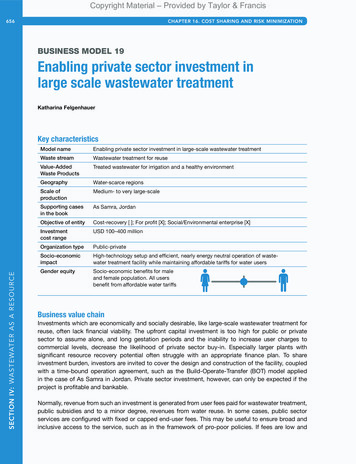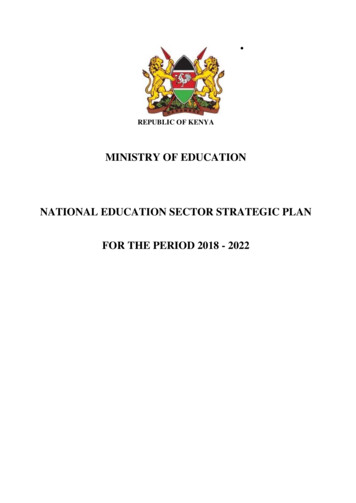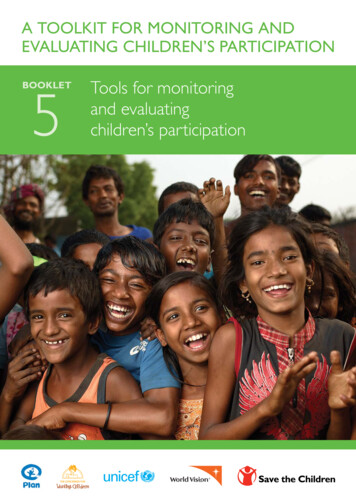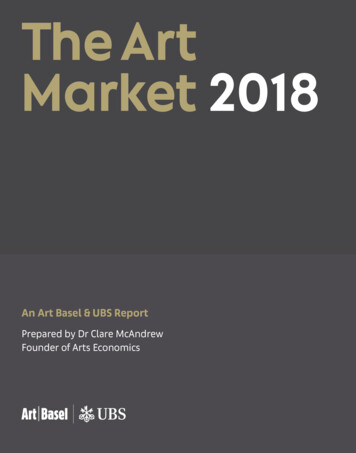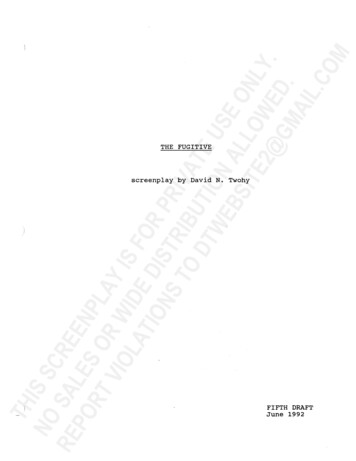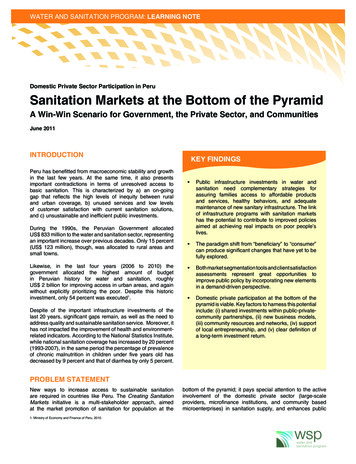
Transcription
WATER AND SANITATION PROGRAM: LEARNING NOTEDomestic Private Sector Participation in PeruSanitation Markets at the Bottom of the PyramidA Win-Win Scenario for Government, the Private Sector, and CommunitiesJune 2011INTRODUCTIONPeru has benefitted from macroeconomic stability and growthin the last few years. At the same time, it also presentsimportant contradictions in terms of unresolved access tobasic sanitation. This is characterized by a) an on-goinggap that reflects the high levels of inequity between ruraland urban coverage, b) unused services and low levelsof customer satisfaction with current sanitation solutions,and c) unsustainable and inefficient public investments.During the 1990s, the Peruvian Government allocatedUS 833 million to the water and sanitation sector, representingan important increase over previous decades. Only 15 percent(US 123 million), though, was allocated to rural areas andsmall towns.Likewise, in the last four years (2006 to 2010) thegovernment allocated the highest amount of budgetin Peruvian history for water and sanitation, roughlyUS 2 billion for improving access in urban areas, and againwithout explicitly prioritizing the poor. Despite this historicinvestment, only 54 percent was executed1.Despite of the important infrastructure investments of thelast 20 years, significant gaps remain, as well as the need toaddress quality and sustainable sanitation service. Moreover, ithas not impacted the improvement of health and environmentrelated indicators. According to the National Statistics Institute,while national sanitation coverage has increased by 20 percent(1993-2007), in the same period the percentage of prevalenceof chronic malnutrition in children under five years old hasdecreased by 9 percent and that of diarrhea by only 5 percent.KEY FINDINGS Public infrastructure investments in water andsanitation need complementary strategies forassuring families access to affordable productsand services, healthy behaviors, and adequatemaintenance of new sanitary infrastructure. The linkof infrastructure programs with sanitation marketshas the potential to contribute to improved policiesaimed at achieving real impacts on poor people’slives. The paradigm shift from “beneficiary” to “consumer”can produce significant changes that have yet to befully explored. Both market segmentation tools and client satisfactionassessments represent great opportunities toimprove public policy by incorporating new elementsin a demand-driven perspective. Domestic private participation at the bottom of thepyramid is viable. Key factors to harness this potentialinclude: (i) shared investments within public-privatecommunity partnerships, (ii) new business models,(iii) community resources and networks, (iv) supportof local entrepreneurship, and (v) clear definition ofa long-term investment return.PROBLEM STATEMENTNew ways to increase access to sustainable sanitationare required in countries like Peru. The Creating SanitationMarkets initiative is a multi-stakeholder approach, aimedat the market promotion of sanitation for population at the1. Ministry of Economy and Finance of Peru, 2010.bottom of the pyramid; it pays special attention to the activeinvolvement of the domestic private sector (large-scaleproviders, microfinance institutions, and community basedmicroenterprises) in sanitation supply, and enhances public
2 Promoting Sanitation Markets at the Bottom of the Pyramid in Peruawareness of sanitation as a business opportunity that alsobenefits local opportunities for development. The model relieson key alliances and interactions among public, private andcommunity actors. These alliances operate at national andsub-national levels, and are meant to allow sustainability andscalability for sanitation markets.Illustration 1: Location of Pilot AreasFour components were designed and tested in order to builda responsive linkage between supply and demand:a. Demand motivation. Motivating demand targetedsanitation-related attitudes, practices, and knowledgeof the population by marketing behavioral change tools.Promotional campaigns, door-to-door messages, andpost-sale educational activities were tested. Local leaders,community sales promoters, school teachers, and healthworkers were all trained to deliver sanitation informationand counseling.La EncañadaNamorab. Local supply. To improve the local supply of goods andservices (suppliers, hardware stores, sales promoters, andforemen), articulation mechanisms were designed requiringthe capacity-building of masons, plumbers, artisans, andhardware store owners. Large-scale suppliers have beeninvolved in this training session’s offerings, as well as localeducational centers and ocLegendPeri urban areaRural areaSmall townDistrictLa EncañadaPopulationHouseholds% withoutaccessto propersanitation*22,3978,43065.5%% acutec**TotalPeru (La Encañada & Namora, Chinchero, Independencia,and Pachacutec). These four pilot areas are representativeof the country’s geographic and cultural diversity and arecharacterized by high levels of poverty (4 of 5 are poor,and 3 of 5 do not have access to proper sanitation), with anestimated population of 174,000 people living in around 47,813households.* includes unimproved latrines** In these districts the pilot did not cover the whole population.Source: Baseline Studies of Creating Sanitation Markets, 2007; and NationalInstitute of Statistics and Informatics (INEI), 2009.ACTIONIn the 2007-2010 period, the Water and Sanitation Program,in conjunction with national and local authorities, the domesticprivate sector, NGOs, and communities, began testing theCreating Sanitation Markets initiative in four pilot areas inProduct design. Market research tools and partnershipbuilding were applied in order to ensure that the sanitationcatalogue of products and related service delivery wasresponsive to people’s expectations. This has implieddomestic private sector involvement in research anddevelopment, as well as the design of a new businessmodel for sanitation micro-enterprises (hardware stores,service providers, and artisans).d. Household financing options. The demand studies ofpilot areas showed that low-income families have beenpaying for sanitation facilities, and are willing to pay forimproved sanitation; but they need proper informationand financial solutions to strengthen their demand. TheCreating Sanitation Markets initiative tested diversefinancing alternatives tailored to households, working withbanks, micro-financial institutions, government subsidyprograms, and NGOs.PILOT PHASE RESULTSFollowing 24 months of sustained promotional activities, andalmost a full additional year of sanitation market development,the following results were achieved:Around nine thousand households have improved theirsanitation services.18 percent of households (roughly nine thousand) in thepilot areas made improvements in their sanitation facilities(11 percent improved their current household sanitaryWater and Sanitation Program
Promoting Sanitation Markets at the Bottom of the Pyramid in Peru 3infrastructure, and 7 percent purchased a new facility). Totalhousehold investment reached US 1.2 million, while theprivate sector has contributed about US 570,000 for training,promotion, and lending.Figure 1: Households that purchased or improved theirbathroom/latrine, and amount investedPercentageof HouseholdsAmmountinvested (US )25%US 714US 800US 61620%US 700US 60015%US 500US 370US 40010%US 300US 357US 54Namora &La EncañadaFigure 3: Sanitation loan portfolio by kind of financialinstitutionUS 100US 1030%US 536 thousand were granted to households by eightfinancial institutions and through three non-regulated financialmechanisms, which designed products adequate for thegranting of loans to families living in the intervention areas(village banks, community saving groups, individual credits).Although 48 percent of loans have been granted by thepublic micro-financial institution in Cusco (CMAC Cusco), aninteresting 23 percent have been granted through communityfinancial mechanisms (village banks and saving groups)reaching low-income populations.US 200US 1145%The sanitation loan portfolio has been estimated ataround US 500,000.US 66IndependenciaChincheroUS 0PachacutecPilot areasTotal ofloans grantedImproved their current bath/latrineMedian invested in credit by familyPurchased a new bath/latrineMedian invested in cash by familySource: Creating Sanitation Markets - Endline Studies. March-April, 2010.{BankFigure 2: Evolution in the access to sanitation as a resultof the pilot phase (baseline-endline)70%14%23%There is a high level of client satisfaction with the localsupply of sanitation goods and services.The sales monitoring system tracked the progress of clientsatisfaction regarding local actors. According to the latestmeasurement, 90 percent of clients are satisfied with hardwarestore goods and services, 86 percent with provider services,80 percent with the micro-financial institutions’ services, and76 percent with communal promoter performance. Globalsatisfaction regarding local sanitation supply is around 83percent, a highlight of market hout accessBaseline2007Endline2010Bathrooms or similarBaseline2007Endline201070%LatrinesEvolution in the access to sanitationSource: Creating Sanitation Markets [Baseline Studies. June, 2007]; [Endline Studies. September, %www.wsp.org48%Source: End Line Studies of Creating Sanitation Markets. March-April, 2010.50%0%Public microfinanceinstitutionCommunitysaving group/NGOFigure 4: Customer satisfaction with service delivered bydomestic local providers60%40%5%Private microfinanceinstitutionThe number of households without access to sanitationdecreased by 35 percent.Deficient access to basic sanitation was reduced from 32percent in 2007 to 21 percent in 2010. This result can beexplained by the impact of the communication campaigns,which have successfully mobilized people to effective action.85 percent of people who remembered the promotionalcampaign also remembered the key messages, 25 percentlooked for information, and 32 percent invested in roviderFinancialInstitutionType of providerSample: 100 people.Source: Monitoring System of Creating Sanitation Markets. September, 2010.
4 Promoting Sanitation Markets at the Bottom of the Pyramid in Perudevelopment of behavioral studies focused on finding thedrivers of change, going beyond socioeconomic research.The studies found that health is not a top family motivator forinvesting in sanitation; in fact, there is a weak link betweenhealth conditions and sanitation in people’s perceptions. Thestudies demonstrated that the main motivator to invest insanitation is actually improving the home, thereby enhancingsocial status. A symbol of progress, water and sanitationsystems are considered part of the urban culture and part ofmodernity. That is why, in the minds of many poor Peruvians,latrines are perceived as a factor of social differentiation.The pilot phase showed that families who invest in sanitationhelp to improve the use, maintenance, and sustainability ofsanitation facilities. Although 39 percent of families in the fourpilot areas are definitely willing to invest in a new sanitationfacility, while 31 percent are willing to invest in the improvementof an existing facility. Sixty-two percent think this investmentwill allow them to feel that they are progressing; 55 percentbelieve that their house will look more modern; and 50 percentthink this investment will make them feel proud of themselves.The interesting findings of the pilot phase have prompted theCreating Sanitation Markets initiative to open the discussioninto core questions, such as: Are we ready to respond todemand expectations? What is the border between the “right”solution for people and the “desired” solution? Who decides?Ms. Juana RamirezChontayoc Community, HuarazMAIN FINDINGS1. Important paradigm shift: from beneficiary to consumerOne of the most important lessons in starting the marketprocess is the promotion of new thinking among market actors,moving their vision of target groups from that of beneficiariesto that of consumers. This involves having market actors takeresponsibility for finding solutions, rather than merely awaitingfor solutions.The NGOs leading the pilot programs invested significanteffort in this paradigm change. They succeeded in convincinglocal actors, as well as their own staff, that this new sanitationapproach was providing subsidized sanitation solutions tothe poor.In facing this great challenge, their first step was to understandconsumers’ expectations, needs, and desires. This led to the2. Better segmentation of the population: identify thediverse segments at the bottom of the pyramid.Poor households have different expectations regardingsanitation facilities, and the pilot interventions have shownthe dual nature of these perceptions. First, there is the privateFigure 5: Clients of Creating Sanitation Markets groupedby household income US 358Monthy HH Income US ”It is so good to have a bathroom for our family, we feel well,happy at home. My daughter feels safer; she says that thebathroom is good for our health. With a bathroom there is morehygiene, especially for the children so they are not walking around .and we can take a relaxed bath”.US 358Poverty LineUS 305 - US 357US 240 - US 304US 186 - US 239US 130 - US 185 US 1290%10%20%30%40%Percentage of PopulationSource: Creating Sanitation Markets - Endline Studies, 2010; National Institute of Statistics and Informatics (INEI), 2009.Water and Sanitation Program
Promoting Sanitation Markets at the Bottom of the Pyramid in Peru 5aspect to be considered by families. Then, there is a publicdimension that relates more to a vision of development andcommunity, and that takes shape in subjects such as thefinal disposal of sludge and solid waste, sanitation baseinfrastructure development (networks, systems, treatmentplants), and operation and maintenance.segments. Four are household segments based on a mix ofincome and saving capacity with bathroom preferences; onesegment focuses on sanitation as a community investment;and the other involves entrepreneurs, looking at sanitation asa mechanism to increase business profits.The payment capacity of poor segments is diverse, andresponds to a wide range of economic activities, income levels,expectations, and demands for social inclusion and progressin life. Some 87 percent of Creating Sanitation Markets clientsare below the poverty line in Peru; 86 percent of these familieshave purchased sanitation facilities, using exclusively their ownresources; 8 percent have made the purchase through credit;and 6 percent used a mixture of both. The median householdinvestment was US 57, and the median credit amount wasUS 536 (in an average of 12 monthly payments). Toilets(43 percent) and sinks (21 percent) were the most frequentlypurchased products.3. Affordable household sanitation involves more thansimply finding the cheapest technology.The objective of providing an affordable sanitation option doesnot mean that the quality of products and facilities must belower. By using a mix of cost-saving measures, addressingfinancing needs, and spreading costs out over time, theCreating Sanitation Markets experience has shown that almostany household can have a high-quality sanitation facility onsite. An affordability strategy should provide options to theconsumer with respect to financing, product, construction,and installation; the timing of all of these components shouldensure that all consumers, regardless of economic status, caninstall the toilet or bathroom they desire and not be obligatedto accept products they do not want.”In the past, we didn’t worry much about cleaning or keeping thebathroom neat. We didn’t pour water down the toilet bowl. Weleft everything dirty. Now I always check that everything is clean,because, can you imagine having a nice but dirty bathroom?”Mrs. Jovita Gutiérrez BrionesNamora, CajamarcaThe Creating Sanitation Markets initiative worked to developan attractive and accessible “sanitation package,” basedon a technology catalogue, installation and maintenanceFigure 6: Financial solution tested according to incomeMonthly incomeby householdEvaluation studies conducted by the Creating SanitationMarkets initiative found that discretionary criteria forsegmentation are related to at least five categories: thehousehold’s income and ability to save, housing ownership,access to credit, the urban experience of family members,and family preferences regarding bathroom conception andmethods of installation and purchase.Taking into account the dual perceptions as well as thediscretionary criteria, it is possible to define six preliminarywww.wsp.orgUS 535US 358Poverty LinePeruvian populationby incomeHigh &Middle classPovertyUS 215Poverty: Lower levelUS 90US 50Financial solution tested byCreating Sanitation MarketsExtreme poverty}}Microfinanceinstitutions' loansCredits through:NGOs, Hardware Stores, andCommunity Water Councils}Market-based subsidiesSource: Creating Sanitation Markets - Endline Studies, 2010;National Institute of Statistics and Informatics (INEI), 2009.
6 Promoting Sanitation Markets at the Bottom of the Pyramid in PeruDespite these results, questions remain. The sustainability ofthe actors’ interaction continues to be a desirable goal, alongwith the development of a sustainable accreditation mechanismfor service providers in order to assure quality standards inan “informal” country such as Peru. Another question involveshow to link people’s desires (a bathroom with shower, sink,and toilet), and their willingness to pay, with the need to usewater more efficiently and ensure that domestic wastewater iseventually treated.One promising effort is headed by six private enterprises(four suppliers, one international commercial bank, and oneprivate foundation), and involves scaling up a sanitationpackage under a unique umbrella brand tentatively called “MiBaño” (My Bath). The package includes goods, constructionand installation services, financing options, information, andorientation through community promoters and points of sale,as well as guaranty and maintenance mechanisms.4. Target financial solutions according to income level.”(The bathrooms) are a good system; it prevents contamination,while silos usually brought bad odor.In the past, I was damaging my house by making a lot of holes forsilos in my yard, I built up to 3 silos. Now everything is nice andclean, the flies have already gone away”.Ms. René Cruzado MorenoPachacutec, Callaoservices, financing services, and information and orientationfor customers. It also worked to create an accessible point ofsale for communities, building a good-quality local sanitationsupply, using local materials and resources, and supportinglocal providers through validation of diverse certificationprograms. These programs were run in conjunction witheducational institutions, private suppliers’ enterprises, andlocal governments.The promotion of market mechanisms at the local level helped toenhance the social and economic dynamic. Local employmentin pilot areas was increased, and 41 percent of the bath/latrineinstallations were done using local service providers, whowere trained by the Creating Sanitation Market initiative. At thesame time local hardware stores have increased their sales,with 48 percent of families now preferring to acquire toilets,sinks, showers, and baths locally.Reaching all income levels of the population requiresinnovative financing alternatives, such as group lending,retail direct credit, or market-based subsidies. The CreatingSanitation Markets results have shown that there are clearlythree segments: the upper poor, who can be easily reachedby the traditional financial sector (banks and microfinanceinstitutions, or MFIs); the middle poor, a key target segmentof the population that does not usually have access to formalfinancial supply; and the bottom poor, people in extremepoverty who receive government subsidies.The first segment has sustainable incomes and/or limited savingcapacity (US 215 to US 358 per month household incomescale). Progressive home improvement financial products area great opportunity for this group. The Creating SanitationMarkets has not had enough success in involving banks andmicro-finance institutions in launching ad-hoc sanitation loans,but there are promising signs, such as dissemination activitiesto increase sanitation awareness and the benefits of theirprioritization in home upgrading; implementation of a systemto pay commissions to promoters or retailers who provide loanclients; and establishment of alliances for sharing sanitationpromotion investments.For those in the middle poor category (US 90 to 215 permonth household income scale), the challenges are greater.The Creating Sanitation Markets initiative has validated diversefinancial alternatives to figure out how to reach that segmentwith a viable, cost-effective financial product. These includethe village banking model through NGOs, and credits directlyfrom hardware stores and community water councils. Althoughthe first Creating Sanitation Markets monitoring reports showclient satisfaction, very low delinquency rates, and increasingaccess, critical barriers remain in replicating these communityfinancing approaches in a sustainable manner. The obstaclesare related to inadequate population profile evaluation tools,and to limited credit terms. The low education level of thisWater and Sanitation Program
Promoting Sanitation Markets at the Bottom of the Pyramid in Peru 7Before and AfterThe domestic private sector has proved a number of things,namely that it is able to deliver household loans for sanitation;that it is able to enhance the knowledge of retailers, improvingthe supply chain and service quality at the point of sale; that itcan support research and innovation to discover new materialsand processes in accordance with environmental policies,resulting in better products in terms of quality, price, andenvironmental impact; that it can create quality informationsystems for consumers and invest in educational campaigns;and that it can improve the quality of health and sanitationrelated conditions for its workers, creating a better physicaland emotional business environment—which in turn can leadto enhanced productivity and well-being.INSIGHTS FOR FUTURE PROGRAMMING“I am very happy with my bathroom. It is close, at hand. Now I do nothave to walk so far, as I did when I had a latrine. My son, who hasarrived from Lima, is happy with the bathroom”.Mrs. Ida ReyesCochac Community, Huarazsegment also requires significant investments in training,regarding how to operate those financial mechanisms. TheNGOs’ successful management of village banks indicatesthat an intermediary is required to promote the formation ofthe group and to provide continuous training and monitoring,which need resources and expertise.Finally, the as yet unanswered question is whether subsidiesare the only alternative for the extremely poor (less than US 90 per month household income scale). The initiative has triedto prove the viability of market-based subsidies by offeringhouseholds opportunities to choose the toilet or bathroom theywould like to have. In the Cajamarca pilot zone, for example,the initiative has formed self-help savings and lending groupswith women members of the direct transfer cash program“Juntos”, a government antipoverty social program thatprovides a bimonthly subsidy of US 70 per household. Thelending model has a cross-guarantee system that allowshouseholds to improve sanitation access through the purchaseof materials or by paying for labor.5. Do not underestimate the private sector’s role.The Creating Sanitation Markets results show enormouspotential for the domestic private sector to contribute toimproved sanitation services for the poor. Peruvian economicgrowth rates highlight opportunities to identify new actors,particularly those interested in improving people’s livingconditions. Today, more than in the past, private sectorenterprises understand that they need consumer satisfactionto survive. When people feel comfortable with their own wellbeing (self-perception, access to basic services, education,etc.), they have greater expectations and needs.www.wsp.orgThe Creating Sanitation Markets pilot projects have shown theexistence of sanitation demand among poor segments at thebottom of the pyramid. It is a heterogeneous demand which,despite the restrictions generated by limited payment capacity,is investing in sanitation services.Why invest in demand development, if it already exists?For two main reasons: (i) because poor households do notnecessarily make the best investment they could makewith their tight resources; and (ii) because there is a latentsanitation demand that requires activation of behaviordrivers to be transformed into real demand. Some of the keybehavioral determinants identified during the interventionprocess are access to financing and information, sanitationvalue perceptions, and skills development.There is promising evidence that private investments byfamilies generate ownership, use, and maintenance ofthe services, contributing to sustainability. That investmentpractice is related to the capacity to choose among diversesanitation facilities; the possibility to fit the selected facilityto their preferences; the right to appeal against goods andservices that do not meet their expectations; and the senseof social inclusion in the chance to afford modern, highquality sanitation access. Therefore, partial or completesubsidy schemes could be incorporated in the CreatingSanitation Markets approach, if the practice continuesin all its aspects. This is not necessarily about incomecapacity; it is more about citizenship-building. An inclusivemarket approach opens new ways to face social developmentchallenges, because customer behavior is finally based onrights and responsibilities, in the correct use of information fordecision-making, and in building capacity for empowermentand ownership.The nurturing of markets for sanitation generates localdevelopment, improved business opportunities, localemployment and income, and interest in other homeimprovement investments. Creating Sanitation Marketsefforts at the local level have demonstrated that sanitation canadd value to small businesses, promote the launch of newenterprises, stimulate providers’ organizations and orient youth
8 Promoting Sanitation Markets at the Bottom of the Pyramid in Peruto new technical education opportunities. Local entrepreneursare not only looking for profits, they also have a commitment totheir community: they seek the progress of their surroundings,and they want to live in a place they feel proud of. In short, thereis a new social process going on. It is supported by economicstability and tranquility, and is generating genuine Peruvianownership, where families seek progress and welfare insidetheir communities, and not outside as in the past.In addition, the Creating Sanitation Markets experience hasproven that the promotion of sanitation markets adds valueto different sectors: private, public, and communities.Moreover, it is not possible to get those benefits withoutsynergy within a shared results framework. The diverse, multistakeholder platforms at national and sub-national levelshave allowed the Creating Sanitation Markets experienceto go forward and indeed “outside the box.” Most likely sucha nationwide alliance is the most promising opportunity toscale up sanitation access at the bottom of the pyramid, andwith genuine quality and sustainability criteria including theenvironmental sustainability. Was the great effort made atthis level an efficient investment, even if there is not enoughevidence of its contribution to the results? Yes it was, becauseany partnership building is based on trust, a long-term processwhich probably represents the most valuable acquisition of thewhole Creating Sanitation Markets inversion.Therefore, this new approach to sanitation implies achange of paradigm and renewed roles for different actors,especially the customers (households and communities)who prioritize sanitation investments, demand information,and use and maintain their sanitation services. An articulatedlocal supply offering, and an integrated solution to customersthat includes goods, services, financing, and information, arealso needed.WSP is a multi-donor partnership created in 1978 and administrated by theWorld Bank to support poor people in obtaining affordable, safe, and sustainable access to water and sanitation services. WSP’s donors include Australia,Austria, Canada, Denmark, Finland, France, the Bill & Melinda Gates Foundation, Ireland, Luxembourg, Netherlands, Norway, Sweden, Switzerland, UnitedKingdom, United States, and the World Bank.The findings, interpretations, and conclusions expressed herein are entirely those of the author and should not attributed to the World Bank or its affiliated organizations, or to the members of the Board of Executive Directors of the WorldBank or the governments they represent. 2011 Water and Sanitation ProgramAcknowledgementsThis Research Brief was prepared byMalva Baskovich, Task Team Leader of theInitiative Creating Sanitation Markets in Peru.Baseline and Endline Studies of the pilotphase were developed by the consultantsRicardo Rojas and Pedro Sandoval; and bythe research firms IMASEN, Directo Peruand Macroconsult/IEP.The infor
Sanitation Markets at the Bottom of the Pyramid A Win-Win Scenario for Government, the Private Sector, and Communities June 2011 INTRODUCTION Peru has benefitted from macroeconomic stability and growth in the last few years. At the same time, it also presents important contradictions in terms of unresolved access to basic sanitation.



